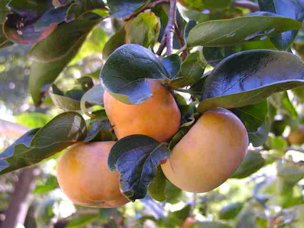From Aggie
Horticulture, Texas A&M AgriLife Extension, Texas A&M
University
System
by David
Rodriguez, County
Extension Agent-Horticulture for Bexar County
Harvesting
Oriental Persimmons

Oriental Persimmons
Oriental
persimmons generally start ripening around late October through the
early part of December in San Antonio and surrounding areas. Much of
the process associated in fruit development and ripening is dependent
upon climate and regional characteristics in all parts of the state.
Persimmons are simply harvested by clipping and leaving the calyx, the
outer set of flower parts. The calyxes sometimes look like leaves, and
in some plants look like petals; they sometimes form a tube on a short
piece of the stem that is attached to the fruit. Fruit is picked when
it has attained the proper color and is still firm to the touch. If
persimmons are picked before fully colored, the fruit will not ripen
evenly, this will make it harder to eat.
What You Need
to Know About Harvesting and Ripening Persimmons:
1)
Careful handling of the fruit is very important in minimizing potential
bruising. Bruising can cause brown spots that decrease marketability.
Using picking buckets (not bags) and rigid bins for transporting fruit
from the orchard will reduce damage.
2) Persimmons are typically
graded for size and quality, and packed for shipping in one to two
layer lugs (a lug is a projecting piece that is used to lift or support
or turn something). Sometimes they come in plastic tray packs, in one
or two layer boxes.
3) Fruit may be ripened in a warm
environment (60° to 70° F) for one to three weeks. Fruit may
be stored at 32° to 34° F to extend the “market
life” for one to four months. Astringent varieties have a longer
shelf life than non-astringent varieties.
Oriental persimmons
can be divided into two classes, astringent and non-astringent
(that’s puckering and non-puckering for us persimmon lovers).
Astringent varieties gain their astringency from soluble tannins that
disappear as the fruit ripens and softens. Non-astringent persimmons,
however, can be eaten when still firm, without any astringency
whatsoever. Some varieties are astringent, if the fruit is not
pollinated; this is referred as parthenocarpic development which is the
production of fruit without fertilization. If varieties are seeded
(fertilized) they are non-astringent.
Instructions on how to eat
and use the fruit should be included in packaging and displayed at the
groceries. There are many untapped local markets for persimmons,
besides shipments to larger urban markets.
Astringent persimmons
that lose their astringency as they ripen can sometimes be slow to
ripen. The process can be hastened by freezing the fruit for 24 hours.
When thawed, they are both soft and free of astringency, and ready to
eat. An apple can be placed with the persimmons in a plastic bag or
among the ripening fruit. Ethylene gas released by the apple will speed
up the ripening process. Periodic flushing with 70-90 percent carbon
dioxide in a sealed chamber for one to four days will also remove
astringency while maintaining fruit firmness, and can prolong shelf
life if done after cold storage. Fruit treated in this manner should be
tested periodically for astringency reduction by placing a cut slice on
dry filter paper, previously treated with 5 percent ferric chloride.
The more intense the color produced, the more astringent the fruit
remains.
Persimmons are delicious whether eaten fresh, dried, or
cooked. As a fresh fruit, they are unsurpassed. The taste of a fully
ripe persimmon is superb, and is incomparable to any other fruit.
Persimmons
can be used fresh in salads, appetizers, or as a dessert or topping,
chilled or frozen. They are excellent in ice cream, with yogurt, or in
smoothies. Cooked or baked, they are delicious in cakes, breads,
puddings, cookies, cobblers, pies, and pastries. Persimmons also make
wonderful preserves and jams.
Freezing is a popular method of
preserving persimmons. They can be peeled before freezing and frozen
whole or pureed in plastic containers. In this manner, they will keep
for a year or more.
Drying is the other principal method of
storage, especially in the Orient. Persimmons may be dried when ripe
and still firm. After being peeled and either sun-dried, dried in a
commercial dryer, or in an oven on low heat, they are stored in air
tight containers in a cool, dark place. Persimmon pulp may also be
spread on foil in a flat pan and dried into jerky. During drying, sugar
crystals form over the surface of the fruit, creating an appealing
product. Dried persimmons are high in dextrose and similar to dried
peaches in food value. An excellent set of recipes can be found in
Persimmons for Everyone by Eugene and Mary E. Griffith, published by
the North American Fruit Explorers, C/O Dorothy Nichols, Route 2, Box
13, Arcola, MO 65603.
Back to
Japanese
Persimmon Page
|
Publication from Aggie Horticulture®
|
